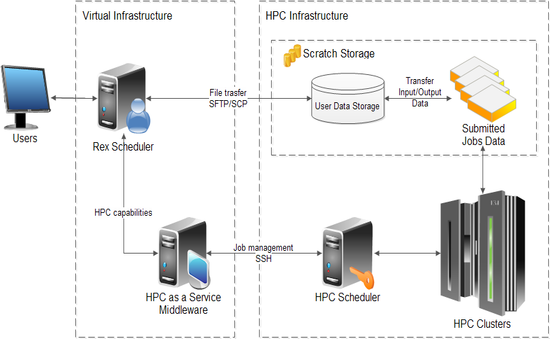Partner: DHI
Field: information technology,
water management, environment
Risks and uncertainties have become the key aspects of the vast majority of decision-making processes. The qualitative assessment of risk is usually based on perception, opinions, judgments, and public or political consensus (or their combination), while the quantitative assessment of risk is based on the results of modeling
methods. To perform disaster risk analysis, modeling techniques using on-line monitoring data are often required. In this context, the ratio between the run time and real time of the modelling cycle is an important aspect. Powerful personal computers are not often able
to run models at a sufficiently fine scale fast enough to obtain relevant results in the required short time. These
results are needed for prognosis and forecasting but mainly for the reaction phase itself.
“HPC as a Service” in hydrological modeling allows hydrological models to be remotely operated on HPC clusters. Using HPC, results of hydrological simulations
can be obtained in a near real-time processing mode, making these results available to support decision making in emergency situations as well as providing possible preventative measures for reducing the risks
and extent of such emergency situations in the future. Moreover, parallelization of a hydrological model and its
remote running using HPC also allow users to increase the accuracy and precision of results by increasing the resolution of meshes whilst maintaining a manageable runtime.
For remote running of hydrological modeling processes on an HPC infrastructure and automated monitoring
and prediction of floods, we created an application interface originally known as “HPC as a Service” in collaboration with the DHI company operating in the
fields of water management and the environment worldwide. This interface integrates an approach to various HPC systems via an object-oriented client-server interface and standard web services. Furthermore, it ensures the availability of desired support functions, such as task management, resource monitoring, messaging, user verification, data transfer, encrypting,
and various notification mechanisms. The new generation of the developed HPC as a Service application interface is known as HEAppE (High-End Application Execution, http://heappe.eu). At present, HEAppE is successfully used in several public and commercial projects (not involving only on hydrological modeling),
where remote access to an HPC infrastructure is required.

PARTNER´S NOTE
Johan Nicolai Hartnack
DHI
“HPC as a Service significantly lowers the entry barrier for users who are interested in using massively parallel computers for efficient running of their simulations. Taking advantage of this service, small and medium-sized enterprises may use this technology with no initial investment in hardware.”

